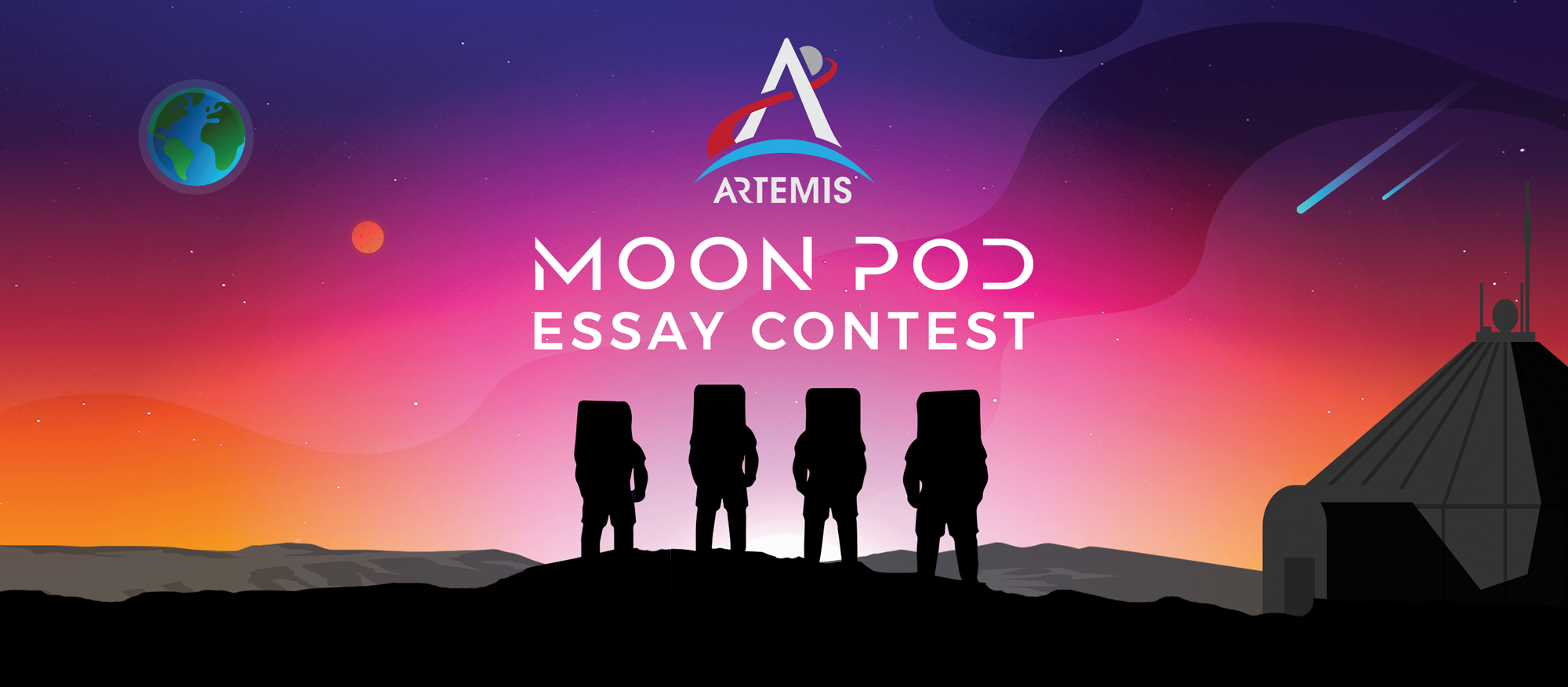


 All About the Moon (K-4)
NASA Interactive Moon
Lunar Reconnaissance
Artemis Mission Page
What is Artemis?
What is Artemis? (K-4)
Artemis Program (5-8)
Orion Spacecraft
Space Launch System
Next Gen Space Suits
Artemis Spacesuits Podcast
Mobile Launcher
Gateway
Preparing To Go
Human Landing System
Moon Landing Sites
Artemis Videos
Lunar Payload Services
In-Situ Resource Utilization
Lunar Surface Innovation Initiative
Viper
Artemis Moon Tools Podcast
Be A NASA Astronaut Podcast
Train Like An Astronaut Podcast
Apollo 50th Anniversary
Apollo 11 Bootprint
Moon History: Apollo Missions
One Giant Leap
Contest Flyer
Take-Home Worksheet
All About the Moon (K-4)
NASA Interactive Moon
Lunar Reconnaissance
Artemis Mission Page
What is Artemis?
What is Artemis? (K-4)
Artemis Program (5-8)
Orion Spacecraft
Space Launch System
Next Gen Space Suits
Artemis Spacesuits Podcast
Mobile Launcher
Gateway
Preparing To Go
Human Landing System
Moon Landing Sites
Artemis Videos
Lunar Payload Services
In-Situ Resource Utilization
Lunar Surface Innovation Initiative
Viper
Artemis Moon Tools Podcast
Be A NASA Astronaut Podcast
Train Like An Astronaut Podcast
Apollo 50th Anniversary
Apollo 11 Bootprint
Moon History: Apollo Missions
One Giant Leap
Contest Flyer
Take-Home Worksheet
Your pod will spend 7 days exploring the lunar South Pole so it's important to know your environment! The Moon does not have an atmosphere like Earth, which means that there is no air to breathe. There is also no protection from the sun and its radiation, so midday temperatures can reach 127°C (hotter than boiling water) whereas at night they can fall as low as -173°C. So you must wear a spacesuit at all times when you are outside your habitat. Also, don’t forget that the moon has about 1/6th the amount of gravity as we have here on Earth, so it will feel like you’re walking on a trampoline!
Large craters at the Moon's South Pole are home to "permanently shadowed regions" that never see sunlight. Robotic missions like the Lunar Reconnaissance Orbiter have revealed that these spots of total darkness may contain patches of frost or ice. Could the ice be melted and filtered for drinking water? Or, could it be broken down into its elements (hydrogen and oxygen) to create breathable air for your spacesuits or rocket fuel to get back home? Many of the crater rims will have near constant sunlight, where you could harvest solar energy to power your rover habitat.
What will define your expedition? How will your crew’s time on the Moon be a building block for the future? What do you hope to learn or accomplish in one week? Will you be building a structure? Conducting an experiment? Exploring a new area? Making a machine? Mining minerals? Harvesting water? Starting a lunar farm? Technology will play a major role in all aspects of your journey. But don’t forget, this is human exploration. Your pod must always thrive and survive – both physically and mentally.
As the leader of the expedition, think about what types of skills you would bring to the team. What are the kinds of personalities or character traits that you would want your crewmates to have? Should they have similar personalities or different? There will be times to relax, laugh, and be silly – just like if you were camping here on Earth. But there will also be extreme situations that may test character - from staying calm while solving a problem to being brave in the face of fear or encouraging others to persevere.
Think about the goals of your expedition and the type of skills that your crew would need for success. Would you work together on a single goal or divide and conquer different tasks? Also, you are 250,000 miles from Earth, so what skills would your pod need to deal with the unexpected, such as if something breaks? Consider how technology may reduce the number of human skills that are needed. For example, do you need a doctor to do daily health check-ups or will you rely on biometric sensors? Or both! Lastly, how will you share your adventure with the billions of people back on Earth cheering you on? Communication is a skill too.
In the history of our world, there have been approximately 570 people that have traveled to space – ever. And when astronauts do travel to space, all eyes are on them. Astronauts inspire not only a nation, but a world. They represent humanity in our quest to explore and understand more about our universe and they become role models for kids across the globe. How will that factor into your crew choices?
NASA’s Space Launch System (SLS) rocket is the most powerful rocket in the world, but it is still limited in how many crew members and how much gear it can bring. What resources ON the Moon might you be able to incorporate into your plan? Similar too how we use water, solar power and raw materials here our Earth, the Moon has resources on its surface (and subsurface!) that may play a role in your mission – from lunar soil to mining metals to harvesting ice. Your pod is only there for one -week, but future astronauts that stay on the Moon for longer durations will need to survive using more than what they bring. Bringing 6 months' worth of water and frozen burritos is HEAVY, and kind of ridiculous, so start thinking and building sustainably for future crews! Maybe your idea will improve life here on Earth too!
NASA has set their sights on exploring the surface of the Moon with human and robotic explorers. Much like NASA has used rovers to study Mars, they plan to do the same on the Moon. Imagine exploring the Moon with robotic helpers. It’s not science fiction anymore, NASA is making it science fact! How could robotic explorers be useful to your crew and future crews? What information do you hope to investigate or discover as you study different areas of the lunar South Pole? What new knowledge might you learn about the Moon, Earth, and our origins in the solar system?
Walking is great. It’s healthy. It’s invigorating. But don’t forget that you are in a spacesuit that’s not quite as comfy as spandex. What if you wanted to explore an area of the moon one mile away where no one has been before? How would you get there? What mobility or transport vehicles might help you or future crews to move around? How will they be powered? Keep in mind there is sun on the crater rims the Moon’s polar mountain peaks (crater rims and ridges), but once you move off those peaks, you are in the crater you will have dark days and dark nights.
To be clear, your essay should be about your time ON the Moon. Nonetheless, we wanted to take a moment to share how NASA’s Artemis program plans to take future astronauts, like you, TO the Moon. A crew of astronauts will ride in the Orion spacecraft, which will sit atop the powerful Space Launch System (SLS) Rocket that travels at speeds up to 24,500 mph. The Orion capsule will dock with an orbiting lunar outpost called “Gateway”. The astronauts will board Gateway as a staging point (it’s kind of like changing planes at an airport, but in space, and orbiting the Moon). Then when the moment is right, astronauts will use lunar landers to travel to the Moon's surface. Three companies are working hard at work designing lunar landers now, including Blue Origin, SpaceX, and Dynetics. And that massive SLS rocket? The winners of this contest will get to watch its first Artemis – 1 launch, so get creative and start writing now! J
NASA has been hard at work developing a plan to go back to the moon, you can read all about it here Artemis Program, but there is no idea too big or too small, or invention too crazy or far-fetched when it comes to space exploration. We can’t wait to hear how you would explore the Moon!
The Artemis Moon Pod Essay Contest is presented in support of NASA's Artemis program. The student challenge is part of NASA's efforts to engage the public in its missions to the Moon and Mars. NASA is returning to the Moon for scientific discovery, economic benefits, and inspiration for a new generation. Working with its partners throughout the Artemis program, the agency will fine-tune precision landing technologies and develop new mobility capabilities that allow robots and crew to travel greater distances and explore new regions of the Moon. On the surface, the agency has proposed building a new habitat and rovers, testing new power systems and much more to get ready for human exploration of Mars. Charged with returning to the Moon in the next four years, NASA’s Artemis program will reveal new knowledge about the Moon, Earth, and our origins in the solar system.
Thank you for your interest in contacting Future Engineers. We look forward to connecting with you!
General Inquiries
support@futureengineers.orgSponsorship Inquiries
sponsor@futureengineers.org